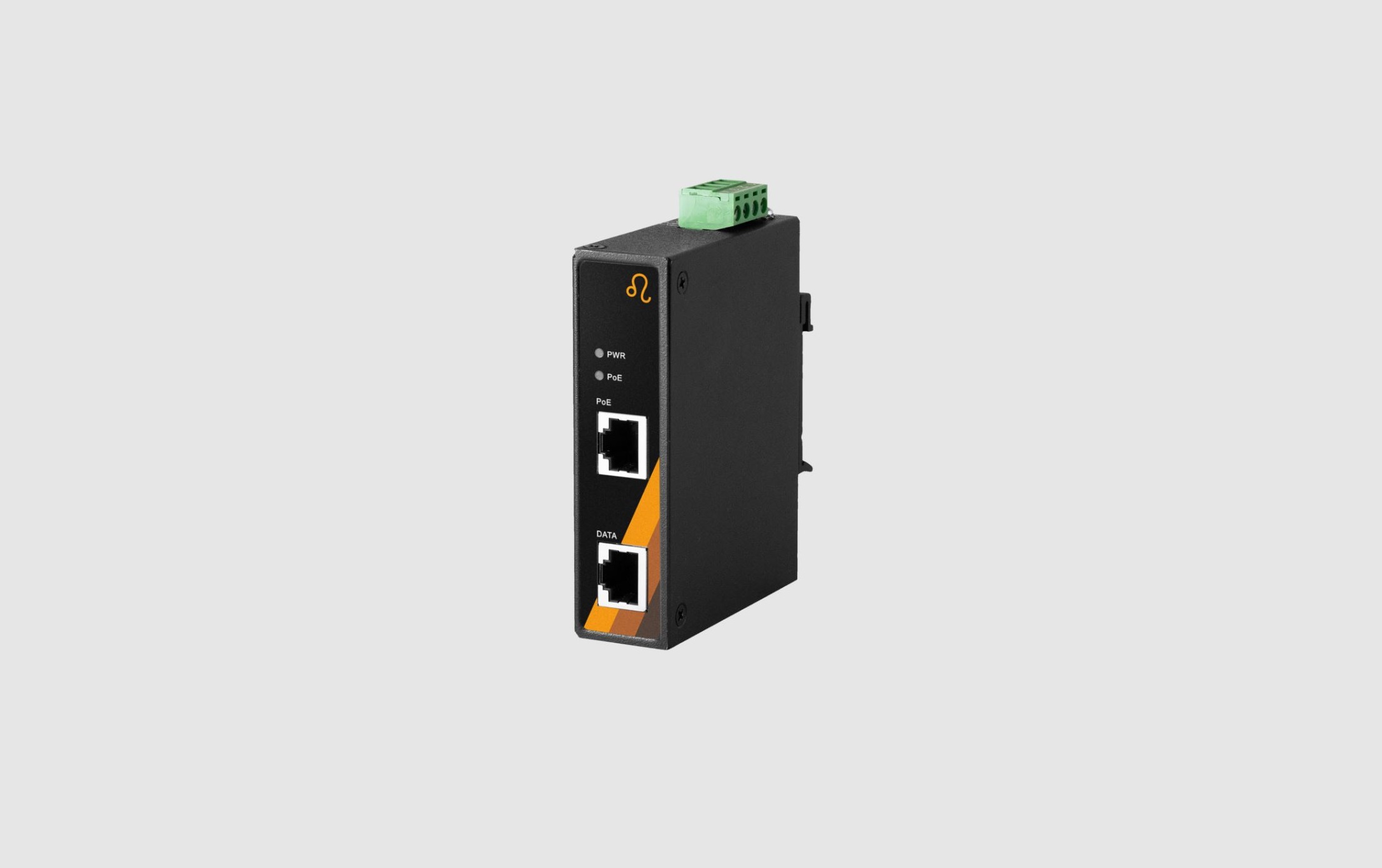Leonton GINJ-0201-EBT, GINJ-0201-EBT-T Industrial Gigabit PoE++ Injector Manual
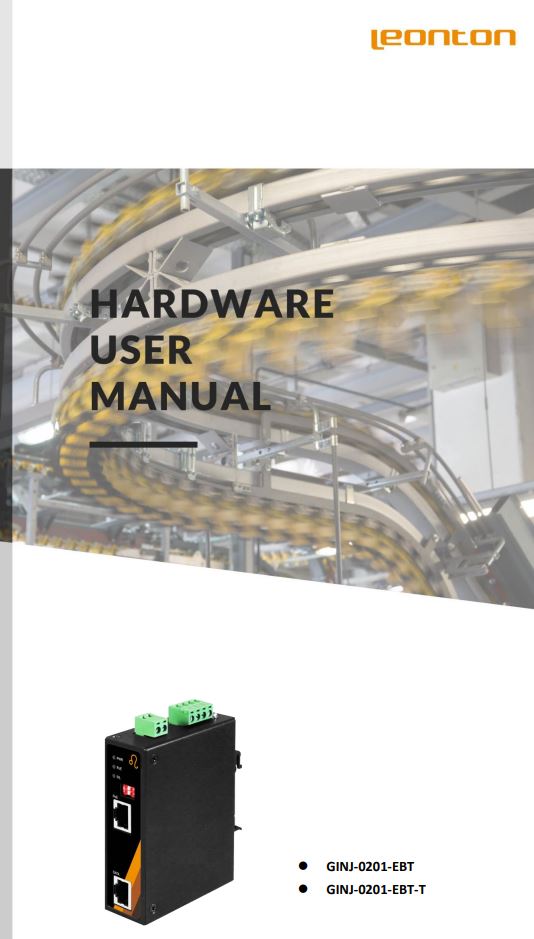
© Copyright 2021 Leonton Technologies Co., Ltd. All Rights Reserved
This document contains information, which is protected by copyright. Reproduction, adaptation or translation without prior permission is prohibited, except as allowed under the copyright laws.
Disclaimer
Leonton Technologies, Co. Ltd. provides this manual without warranty of any kind, expressed or implied, including but not limited to the implied warranties of merchantability and fitness for a particular purpose. Leonton Technologies, Co. Ltd. may make improvements and/or changes to the product and/or specifications of the product described in this manual, without prior notice. Leonton Technologies, Co. Ltd. will not be liable for any technical inaccuracies or typographical errors found in this guide. Changes are periodically made to the information contained herein and will be incorporated into later versions of the manual. The information contained is subject to change without prior notice.
FCC Notice
This equipment has been tested and found to comply with the limits for a Class-A digital device, pursuant to Part 15 of the FCC rules. These limits are designed to provide reasonable protection against harmful interference in a residential installation. This equipment generates, uses, and can radiate radio frequency energy. It may cause harmful interference to radio communications if the equipment is not installed and used in accordance with the instructions. However, there is no guarantee that interference will not occur in a particular installation. If this equipment does cause harmful interference to radio or television reception, which can be determined by turning the equipment off and on, the user is encouraged to try to correct the interference by one or more of the following measures:
- Reorient or relocate the receiving antenna.
- Increase the separation between the equipment and receiver.
- Connect the equipment into an outlet on a circuit different from that to which the receiver is
connected. - Consult the dealer or an experienced radio/TV technician for help.
Caution: Any changes or modifications not expressly approved by the grantee of this device could void the user’s authority to operate the equipment.
CE Mark Warning
This is a Class-A product. In a domestic environment this product may cause radio interference in which case the user may be required to take adequate measures.
This document is the current official release manual. Please check our website (www.leonton.com) for any updated manual or contact us by e-mail (sales@leonton.com).
OVERVIEW
PoE and Non-PoE are both highly utilized in industrial networking applications nowadays; however, it sometimes goes to an awkward situation that end-device, e.g. remote camera, supports PoE function but the Ethernet switch does not. Is there any other solution but replacing the switch with a PoE one?
GINJ-0201-EBT Series solve the problem simply by deploying data and power from non-PoE switch and power input to the PD device. PoE injector is a brilliant low-cost solution for the case that only one side of the device is supporting PoE function. Therefore GINJ-0201-EBT Series will be your best choice to deal with the lack of PoE function cases.
Additionally, GINJ-0201-EBT Series supports power input from 48VDC to 55VDC, ensuring full 90W PoE output, in compliance with IEEE 802.3bt standard for better usage in various industrial markets, like automation, surveillance, and vehicle industry. Besides that, with the fan-less design, this model series also works perfectly in polarized temperatures from -40~75 and undoubtedly becomes your best option in a harsh environment.
GINJ-0201-EBT Series with a fan-less design, besides extending surely apply to various industrial applications, works perfectly in polarized temperature from -40~75, and undoubtedly becomes your best option in the industrial market.
Key Features
Interface & Performance
- Embedded 1*10/100/1000Tx for LAN-In and 1*10/100/1000Tx for BT PoE P.S.E. Out
- Compliant with IEEE802.3af/at/bt PoE technologies
- Support auto detection and classification for PoE application
- Support short-circuit and current-overloading protection for PoE application
Power Input
- GINJ-0201-EBT: Dual 48-55VDC redundant power inputs
- 1*4-pin removable terminal block
- Max. current 2.2A (Included PoE power budget)
- Max. PoE output: 100W
Certification
- CE/FCC
- UL 61010-1
- UL 61010-2-201
Operating Temperature
- Standard operating temperature model: -10°C ~ 65°C
- Extended operating temperature model (–T): -40°C ~ 75°C
Case/Installation
- IP30 protection (not certified by UL)
- DIN-Rail and wall mount design
- Installation in a pollution degree 2 industrial environment
- Installation in the environment with adequate airflow
- Standalone Installation
Package Contents
- 1 – GINJ-0201-EBT(-T) – Unit weight: 0.362 kg (0.8 lbs.), Shipping weight: 0.508 kg (1.12 lbs.)
- 2 – Wall mounting brackets and screws
- 1 – Quick installation guide
Safety Precaution
Attention
If the DC voltage is supplied by an external circuit, please use a protection device on the power supply input. Supply by UL Listed industrial use power. The industrial Ethernet injector’s hardware specs, ports, cabling information, and wiring installation will be described within this user manual.
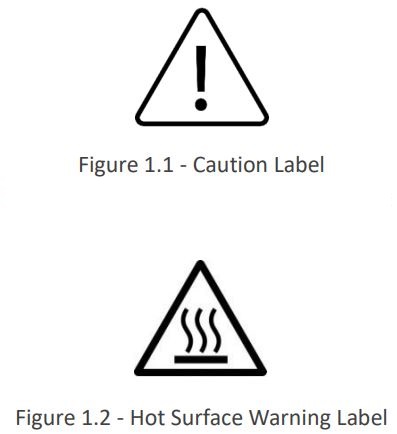
HARDWARE DESCRIPTION
Physical Dimensions
Figure 2.1, below, shows the physical dimensions of GINJ-0201-EBT Series.

Front Panel
The front panel of the GINJ-0201-EBT Series Industrial Gigabit BT-PoE Injector is shown below in Figure 2.2.
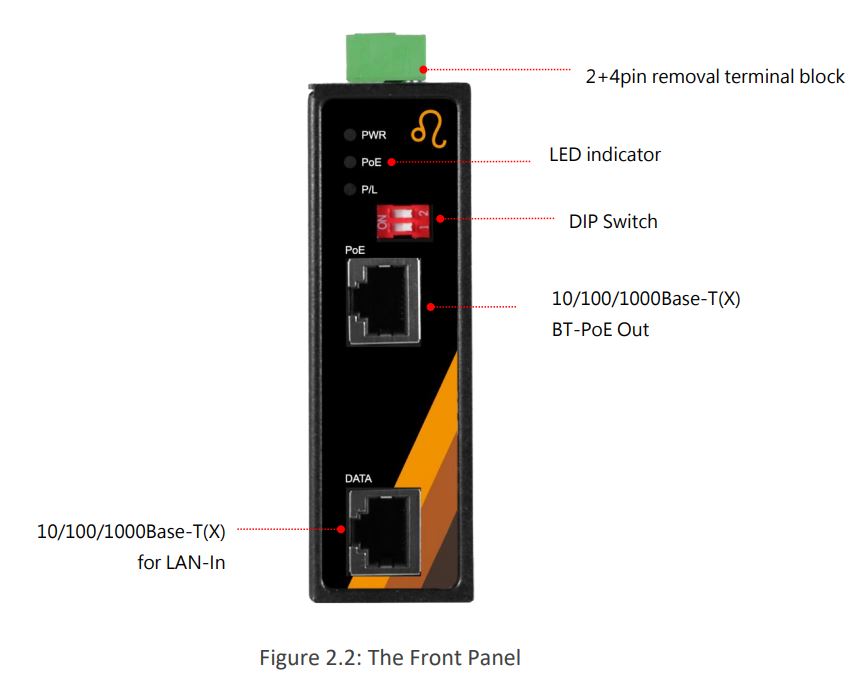
Top View
Figure 2.3, below shows the top panel of the GINJ-0201-EBT Series Industrial Gigabit BT-PoE Injector that is equipped with one 2-pin terminal block for relay contact alarm and 4-pin terminal block connectors for dual DC power inputs (48-55VDC).

LED Indicators
There are LED light indicators located on the front panel of the industrial injector that display the power status and network status. Each LED indicator has a different color and has its own specific meaning, see below in Table 2.1.
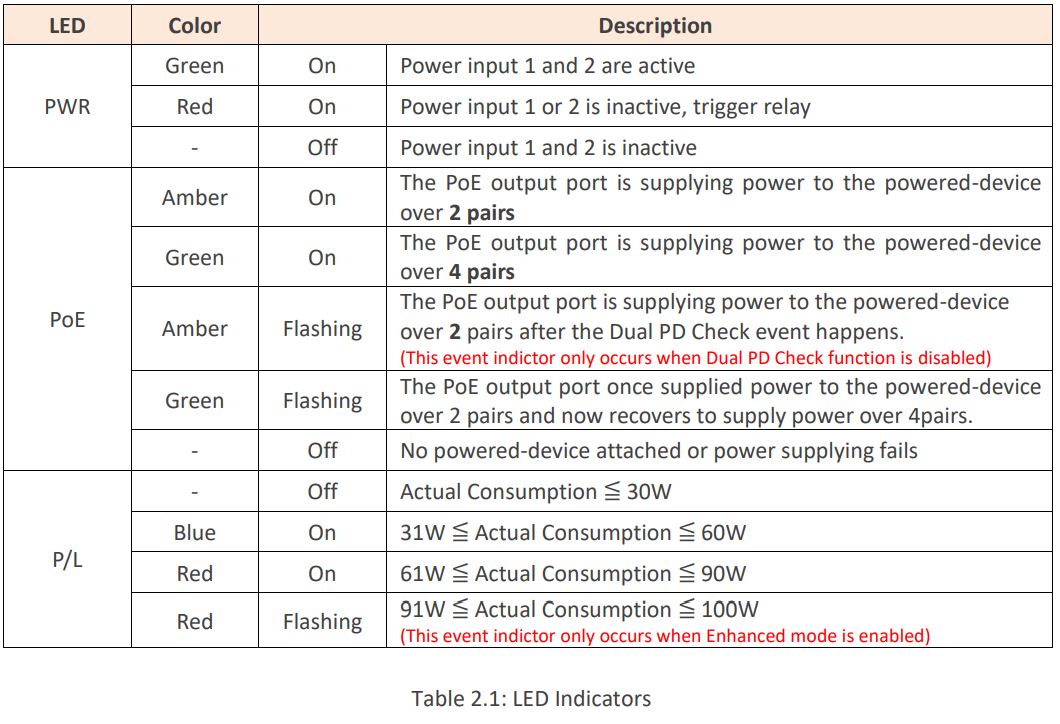
DIP-Switch Setting
There are 2-set DIP-switch in front panel, that can be used for setting the PoE Mode and Dual PD Check functions. The default setting for all DIP switches is “OFF”. See the Table 2.2 and description below for more details.

DIP Switch 1
OFF: Enable “Standard PoE Mode” function. The PoE Output will be activated following IEEE 802.3af, IEEE 802.3at, IEEE 802.3bt PoE Standard
ON: Enable “Enhanced PoE Mode” The PoE Output will be activated based on the used pairs. If the PSE output is over 2pairs, the max.
PoE budget is 50W; If the PSE output is over 4pairs, the max. PoE budget is 100W.
DIP Switch 2
OFF: Disabled “Dual PD Check” function When Dual PD Check is disabled, the port will detect, classify and service power on request for either channel regardless of the detection result on the other channel.
ON: Enabled “Dual PD Check” function When Dual PD check is set, if an invalid detection signature is discovered on either channel, the port
will not perform classification or grant power on requests.
[Note]
- When Dual PD Check is disabled in Standard PoE Mode and one of the channels fails, the PoE budget will be based on the classification of the valid channel.
- When Dual PD Check is disabled in Enhanced PoE Mode and one of the channels fails, the PoE budget will becomes max.50W over 2 pairs.
Relay Contact Alarm Warning
The relay contact alarm supports power redundancy failed, PoE total output watts >100% warning and PoE over current or cable short warning. There are 5 key trigger events, please follow the below rules:
The relay contact alarm will be triggered when anyone of the listed events occurs.
Key trigger event 1: Power-1 or Power-2 is inactive
Key trigger event 2: PoE total loading >100% PoE output budget
Key trigger event 3: PoE over current per port
Key trigger event 4: Cable short per port
Key trigger event 5: One of the channels in Dual PD fail
[Notice] When the relay is triggered because of Event 2~5, the relay contact alarm, will update the status every 30 seconds. If there is no event happening for 30 seconds, the relay contact alarm will be turn off. If the user disables the failed PoE port by removing the cable or Dip Switch manually, the relay will be recovered immediately.
Ethernet Ports
RJ-45 Ports (Auto MDI/MDIX)
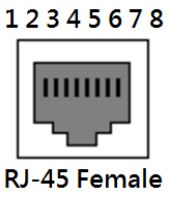 The RJ-45 ports are auto-sensing for 10Base-T, 100Base-TX or 1000Base-T devices connections. Auto MDI/MDIX means that the unit can connect to another one or workstation without changing the straight-through or crossover cabling. See the figures as below for straight-through and crossover cabling schematics.
The RJ-45 ports are auto-sensing for 10Base-T, 100Base-TX or 1000Base-T devices connections. Auto MDI/MDIX means that the unit can connect to another one or workstation without changing the straight-through or crossover cabling. See the figures as below for straight-through and crossover cabling schematics.
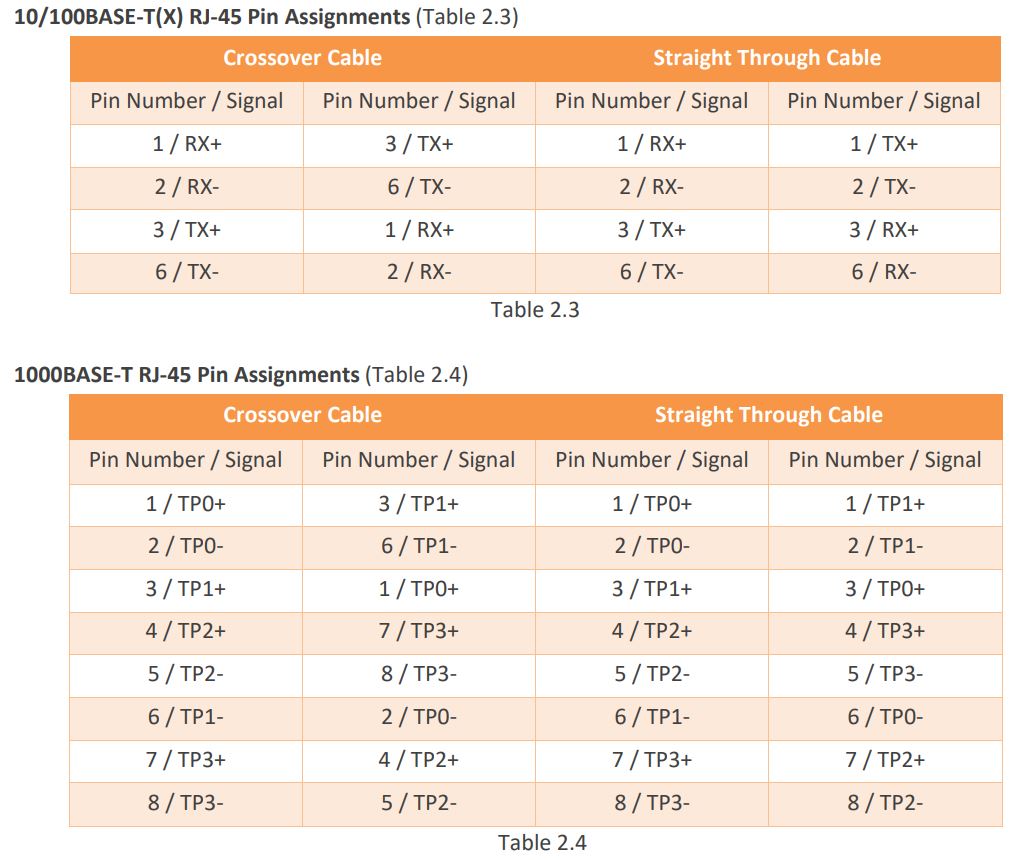
Note: “+” and “-” signs represent the polarity of the wires that make up each wire pair.
Cabling
Use the four twisted-pair, category 5e, or the above cabling for RJ-45 port connections. The total length from the device A through the injector to the device B must not exceed 100 meters.
Wiring the Power Inputs

Step 1 Insert the positive and negative wires into the PWR1 (V1+, V1-) and PWR2 (V2+, V2-) contacts on the terminal block connector as shown below in Figure 2.4.
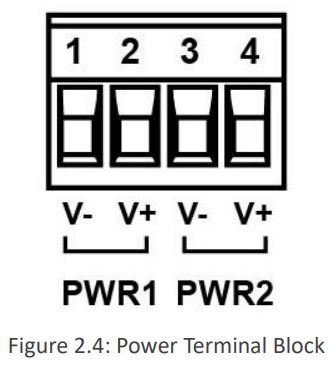 Step 2 Tighten the wire-clamp screws to prevent the wires from loosening, as shown below in Figure 2.5.
Step 2 Tighten the wire-clamp screws to prevent the wires from loosening, as shown below in Figure 2.5.
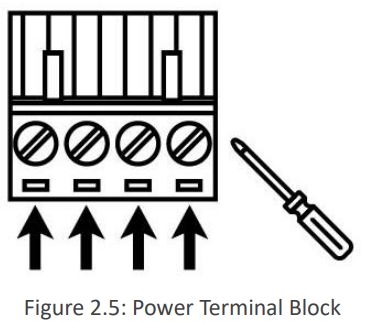

Wiring the Fault Alarm Contact
The fault alarm contact is on the 2-pin terminal block connector as the picture shown below. By inserting the wires, it will detect the fault status including power failure or port link failure (managed industrial switch only) and form a normally open circuit. An application example for the fault alarm contact is shown below in Figure 2.6.
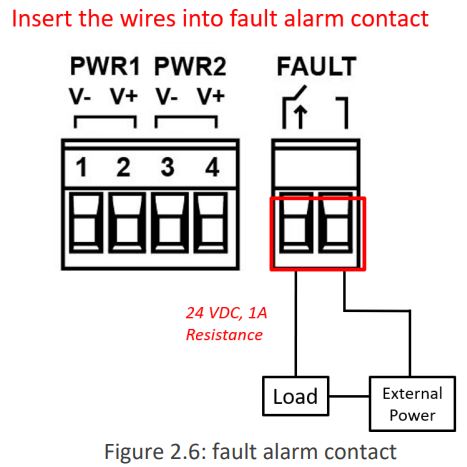
Grounding Note
Grounding and wire routing help limit the effects of noise due to electromagnetic interference (EMI). Run the ground connection from the ground screw to the grounding surface prior to connecting devices. The grounding screw symbol is shown blow in Figure 2.7.
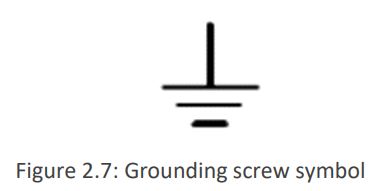

MOUNTING INSTALLATION
DIN-Rail Mounting
The DIN-Rail is pre-installed on the injector from the factory. If the DIN-Rail is not on the unit, please see Figure 3.1 to learn how to install the DIN-Rail on it.
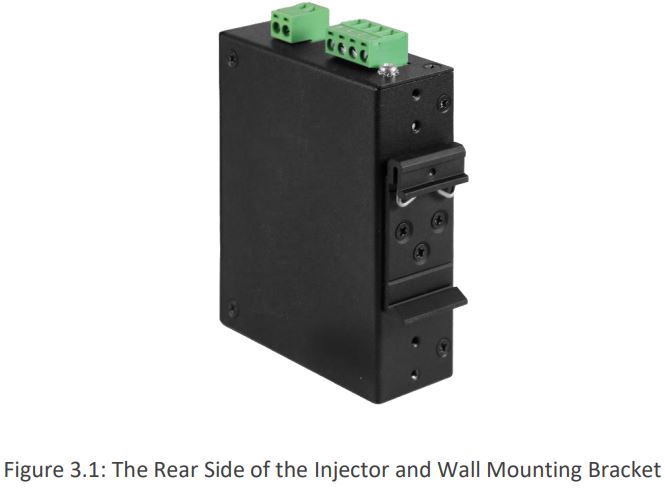
Follow the steps below to learn how to hang the industrial Ethernet injector.
Step 1. Use the screws to install the DIN-Rail bracket on the rear side of the industrial Ethernet injector.
Step 2. To remove the DIN-Rail bracket, do the opposite from Step 1.
Step 3. After the DIN-Rail bracket is installed on the rear side of the injector, insert the top of the DIN-Rail
on to the track as shown below in Figure 3.2.
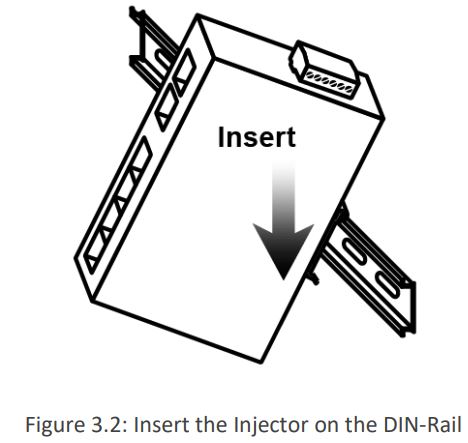 Step 4. Lightly pull down the bracket on to the rail as shown below in Figure 3.3.
Step 4. Lightly pull down the bracket on to the rail as shown below in Figure 3.3.
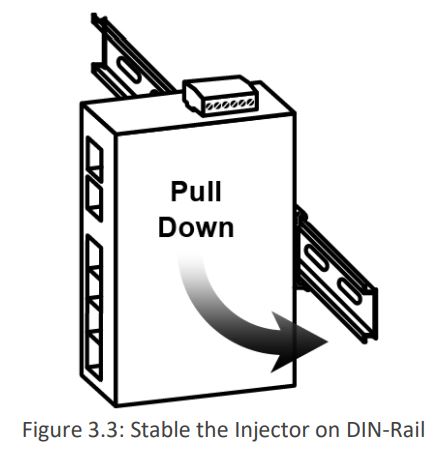
Step 5. Check if the bracket is mounted tightly on the rail. Step 6. To remove the industrial Ethernet injector from the rail, do the opposite from the above steps.
Wall Mounting
Follow the steps below to mount the industrial Ethernet injector using the wall mounting bracket as shown below in Figure 3.4.
Step 1. Remove the DIN-Rail bracket from the industrial Ethernet injector by loosening the screws.
Step 2. Place the wall mounting brackets on the top and bottom of the industrial Ethernet injector.
Step 3. Use the screws to screw the wall mounting bracket on the industrial Ethernet injector.
Step 4. Use the hook holes at the corners of the wall mounting bracket to hang the industrial Ethernet injector on the wall.
Step 5. To remove the wall mount bracket, do the opposite from the steps above.
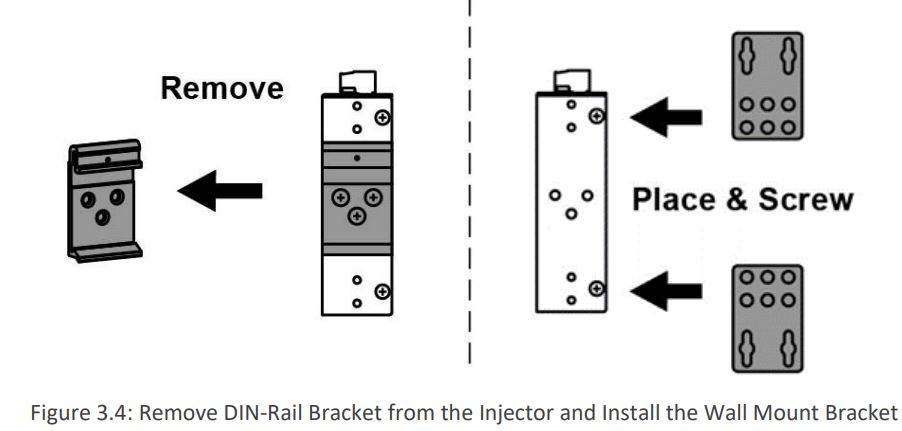
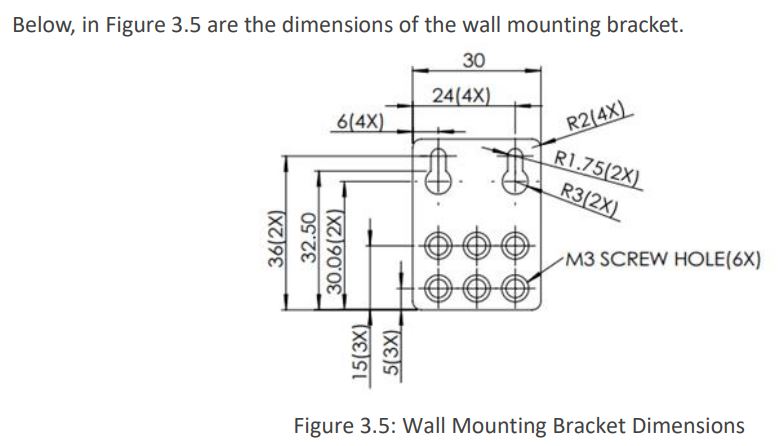
HARDWARE INSTALLATION
Installation Steps
This section will explain how to install GINJ-0201-EBT Series. Installation Steps
Step 1. Unpack the industrial injector from the original packing box.
Step 2. Check if the DIN-Rail bracket is screwed on the industrial injector.
- If the DIN-Rail is not screwed on the industrial injector, please refer to the DIN-Rail Mounting section for DIN-Rail installation.
- If you want to wall mount the industrial injector, please refer to the Wall Mounting section for wall mounting installation.
Step 3. To hang the industrial injector on a DIN-Rail or wall, please refer to the Mounting Installation section.
Step 4. Power on the industrial injector and then the power LED light will turn on. - If you need help on how to wire power, please refer to the Wiring the Power Inputs section.
- Please refer to the LED Indicators section for LED light indication.
Step 5. Prepare the twisted-pair, straight-through category 5 cable for Ethernet connection.
Step 6. Insert one side of the RJ-45 cable into injector’s Ethernet port and on the other side into the networking device’s Ethernet port, e.g. switch, PC or server. - Please refer to the LED Indicators section for LED light indication.
Step 7. When all connections are set and the LED lights all show normal, the installation is complete.





Note: Clean the device with soft cloth with dry or water.
TROUBLE SHOOTING
- Verify you have the right power cord or adapter. Never use a power supply or adapter with a noncompliant DC output voltage or it will burn the equipment.
- Diagnosing LED Indicators: To assist in identifying problems, the unit can be easily monitored with the LED indicators which help to identity if any problems exist.
- Please refer to the LED Indicators section for LED light indication.
- If the power indicator LED does not turn on when the power cord is plugged in, the user may have a problem with the power cord. Check for loose power connections, power losses or surges at the power outlet.
- Please contact Leonton for technical support service, if the problem still cannot be resolved.
- If the industrial injector LED indicators are normal and the connected cables are correct but the packets still cannot transmit, please check the system’s Ethernet devices’ configuration or status.
For any repair or maintenance needs, please contact us. LEONTON TECHNOLOGIES, CO., LTD
9F-1, No.43, Fuxing Rd., Xindian Dist., New Taipei City, 231, Taiwan
TEL: +886 2 22183113
FAX: +886 2 22187391
